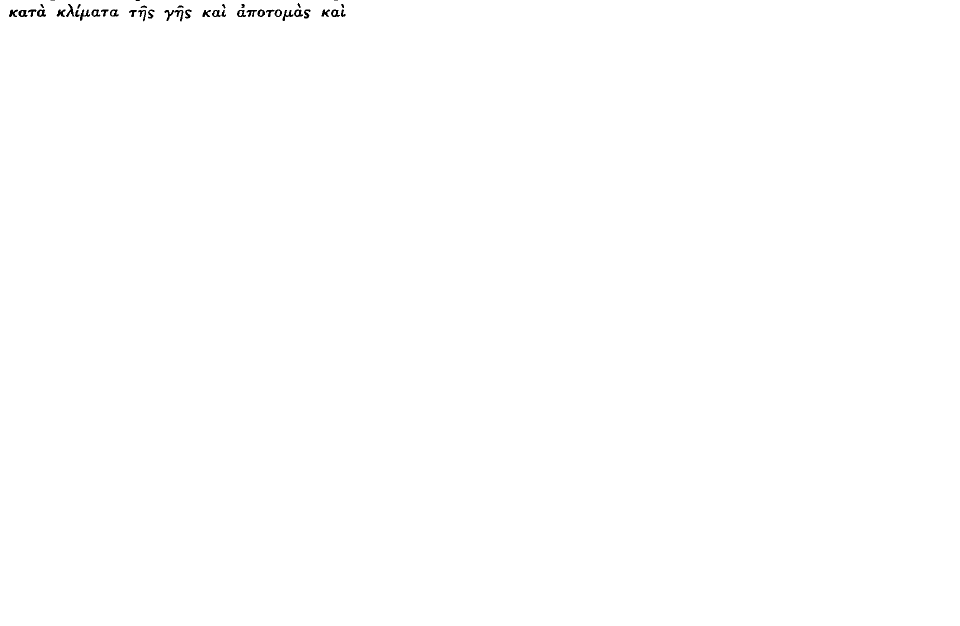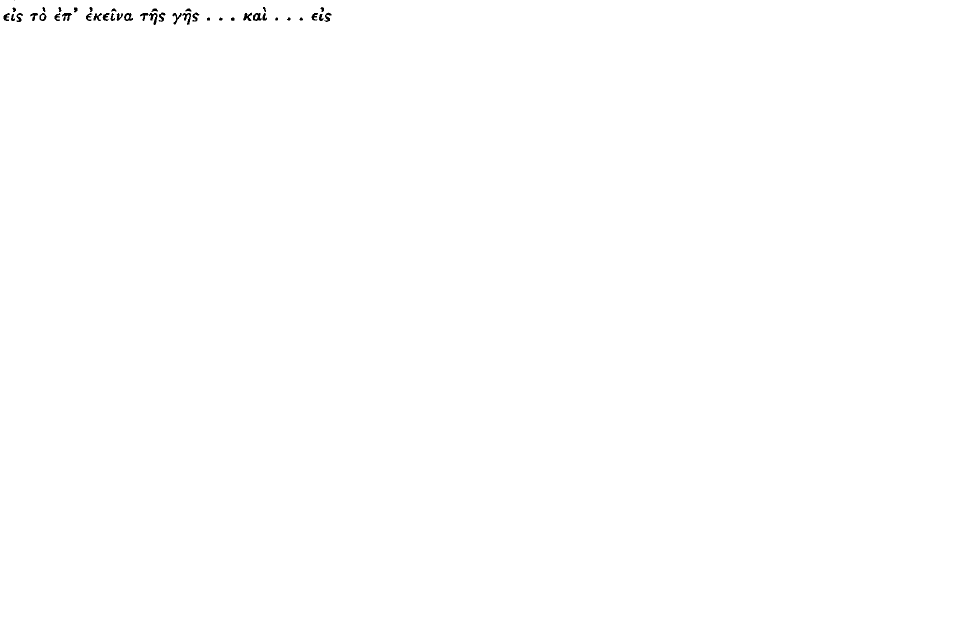Article contents
Phaedo III c 4 ff
Published online by Cambridge University Press: 11 February 2009
Extract
The publication of Mr. R. S. Bluck's stimulating Phaedo prompts me to ask the following questions concerning the traditional interpretation of the cosmographical passage beginning 108 e. (1) Do the terms of 108 e-109 a in combination with 110 b 5 ff. and Timaeus 40 b-c and 62 d ff. prove conclusively that in the Phaedo Plato thinks of the earth as a spherical body? (2) Granted that he does, need his description of the earth, as a setting for his eschatological myth, conform with the spherical theory?
- Type
- Articles
- Information
- Copyright
- Copyright © The Classical Association 1956
References
page 193 note 1 Strictly speaking, the Timaeus tells us nothing whatever about the shape of the earth. Cf. the commentaries of Taylor, , pp. 226 ff., 237,Google Scholar and Cornford, , pp. 120 ff., 134.Google Scholar
page 193 note 2 The picture of underground rivers of water and fire agrees with the views which Seneca, natur. quaest. 6. 7 ff. ascribes to quidam, i.e. some writers in the succession of Thales. In spite of Friedländer, P., Platon, vol. i (Berlin, 1928), p. 243,Google Scholar note 1, and Cherniss, H. F., Aristotle s Criticism of Presocratic Philosophy (Baltimore, 1935), pp. 395–6,Google Scholar the argu ments of Frank, E., Plato und die sog. Pythagoreer (Halle, 1923), pp. 184 ff.,Google Scholar still hold: there is no reliable evidence to connect the discovery of the sphericity of the earth widi any of the pre-Socratics, not excluding Parmenides, whose horizontally oriented zones were later falsely identified with the global zones as inscribed by Aristotle and his followers; cf. Heidel, W. A., The Frame of the Ancient Greek Maps (New York, 1937)Google Scholar and the same audior's The Heroic Age of Science (Baltimore, 1933), p. 98.Google ScholarMondolfo, R., in Rend. R. Accad. d. Scienze dell' Istituto diBologna, Scienze Morali ser. 3, vol. x (1937), pp. 79 ff., tries to revive the ascription to Parmenides, but he relies too much on the Hippocratic whose date and provenance are very dubious.Google Scholar
whose date and provenance are very dubious.Google Scholar
page 194 note 1 Throughout the present passage the preposition  is horizontally directed. Here it refers to the circular expanse of the earth's surface. The area embraced need not of course, be strictly circular; cf. the rect angular walls of Babylon, Herodotus 1. 179:
is horizontally directed. Here it refers to the circular expanse of the earth's surface. The area embraced need not of course, be strictly circular; cf. the rect angular walls of Babylon, Herodotus 1. 179:  Better yet, cf. Critias 118 d.
Better yet, cf. Critias 118 d.
page 194 note 2 For the most part,  equals
equals  In other words, the areas, inhabited or uninhabited, each of them at least potentially an
In other words, the areas, inhabited or uninhabited, each of them at least potentially an  , which make up the vast earth, are usually coextensive with the
, which make up the vast earth, are usually coextensive with the  cf. 109 b 4–5. In a later passage, however, 112 c 6, d 1,
cf. 109 b 4–5. In a later passage, however, 112 c 6, d 1,  seems to refer to a subdivision of our
seems to refer to a subdivision of our  The reason for this lack of precision may be explained as follows. When Plato talks about the earth, he has in mind either the vast horizontally oriented expanse with its numerous
The reason for this lack of precision may be explained as follows. When Plato talks about the earth, he has in mind either the vast horizontally oriented expanse with its numerous  (let us call this: image I), or our particular
(let us call this: image I), or our particular  (image II), or a mixture of the two, a horizontal plain sloping downward towards the middle, but divided into zones (image III); for the last, cf. Xenophanes A 41 a Diels = Aëtius 2. 24. 9:
(image II), or a mixture of the two, a horizontal plain sloping downward towards the middle, but divided into zones (image III); for the last, cf. Xenophanes A 41 a Diels = Aëtius 2. 24. 9: 
 Also Parmenides A 44 a Diels, espe cially Aet. 3. 11. 4 where we find a similar use of
Also Parmenides A 44 a Diels, espe cially Aet. 3. 11. 4 where we find a similar use of  It is this mixed image which is responsible for the location of several
It is this mixed image which is responsible for the location of several  in what appears to be one
in what appears to be one  What I have called Plato's lack of precision seems to be connected with a similar multiple reference in earlier scientific writing. In their remarks about
What I have called Plato's lack of precision seems to be connected with a similar multiple reference in earlier scientific writing. In their remarks about  the pre-Socratics were as likely to have in mind the cartographical arrangement of the
the pre-Socratics were as likely to have in mind the cartographical arrangement of the  as the theoretical shape of the body of the earth (Xenophanes B 28 Diels), or again the characteristics of the element
as the theoretical shape of the body of the earth (Xenophanes B 28 Diels), or again the characteristics of the element  as contrasted with
as contrasted with  and
and  (Empedocles B 37;39).
(Empedocles B 37;39).
page 194 note 3 The central cavity runs parallel to the lesser channels, i.e. horizontally. But instead of merely connecting one hollow with another (image I) it runs below all of the hollows, from one end of the earth to the other. According to the usual interpretation (cf. most recently Bluck, R. S., Phaedo [London, 1955], p. 135)Google Scholar Tartarus cuts through the centre of a globular earth, running roughly north to south along the axis of the sphere. But Tartarus, which in Homer and popular myth is regarded as a horizontally oriented space below the earth, would be an awkward name for such a monstrosity, and Plato would not go out of his way to cite the reference if his cavity were entirely different from that of Hesiod and Homer. Even Aristotle, who misunderstands Plato's purpose and tries to fit the account into his own spherical scheme (meteor. 2. 2. 355 b 32 ff.), seems to think of the central chasm and its see-saw along vaguely horizontal lines; the verb he chooses,  whatever its significance, has centripetal force, and is thus not suitable to designate linear extension. The confusion has been further compounded by a comparison with Timaeus 40 b-c where Plato does refer to an axis, and Taylor, in his commentary p. 234, note 2, proposes to substitute
whatever its significance, has centripetal force, and is thus not suitable to designate linear extension. The confusion has been further compounded by a comparison with Timaeus 40 b-c where Plato does refer to an axis, and Taylor, in his commentary p. 234, note 2, proposes to substitute  the verb of the Timaeus passage, for Aristotle's
the verb of the Timaeus passage, for Aristotle's  Thus Aristotle's vagueness has become responsible for a notorious problem of interpretation; cf. Cornford, F. M., Plato's Cosmology (London, 1937), p. 122.Google Scholar Later writers follow Aristotle in imposing a spherical perspective, until in Dante Hell becomes a funnel, and the rivers are located one above the other, whereas in Plato, as will appear below, all four rivers lie on the same level.
Thus Aristotle's vagueness has become responsible for a notorious problem of interpretation; cf. Cornford, F. M., Plato's Cosmology (London, 1937), p. 122.Google Scholar Later writers follow Aristotle in imposing a spherical perspective, until in Dante Hell becomes a funnel, and the rivers are located one above the other, whereas in Plato, as will appear below, all four rivers lie on the same level.
page 195 note 1  and
and  here do not refer to Tartarus, in spite of Pindar fr. 207 Snell et al., but to the fluid. The words are almost synonymous, denoting here not ‘bottom’ but ‘fixed position’. For
here do not refer to Tartarus, in spite of Pindar fr. 207 Snell et al., but to the fluid. The words are almost synonymous, denoting here not ‘bottom’ but ‘fixed position’. For  see Plato, , Cratylus 437Google Scholar a where it is contrasted with
see Plato, , Cratylus 437Google Scholar a where it is contrasted with  For
For  cf. Aeschylus, , Prom. 1046:
cf. Aeschylus, , Prom. 1046: 
 also Solon 1. 20 Diehl.Google Scholar
also Solon 1. 20 Diehl.Google Scholar
page 195 note 2 
 the underlying conception is image I. ‘The region beyond’ refers comprehensively to other hollows, divided from
the underlying conception is image I. ‘The region beyond’ refers comprehensively to other hollows, divided from 
 , our own hollow, by what Plato had earlier called the ‘true earth’: 110 a 1, 8 ff. Both the ‘true earth’ and the hollows outside of our own particular hollow are situated
, our own hollow, by what Plato had earlier called the ‘true earth’: 110 a 1, 8 ff. Both the ‘true earth’ and the hollows outside of our own particular hollow are situated  There are, of course, no rivers of any kind on the true earth; cf. 11 o c 7:
There are, of course, no rivers of any kind on the true earth; cf. 11 o c 7: 
 That this deprives the men who have lived exceptionally well (114b 6-c 2) of a means of transportation does not seem to have bothered Plato.
That this deprives the men who have lived exceptionally well (114b 6-c 2) of a means of transportation does not seem to have bothered Plato.
page 195 note 3 The particle  indicates, with self-conscious emphasis, that our region has earlier been shown to rest at the bottom of a
indicates, with self-conscious emphasis, that our region has earlier been shown to rest at the bottom of a  cf. 109 c ff. I am inclined to think that
cf. 109 c ff. I am inclined to think that  is an interpolation, though I have retained it in the translation. It dupli cates
is an interpolation, though I have retained it in the translation. It dupli cates  of 112 c 1. If I am right, the plural noun was added to create an antece dent for
of 112 c 1. If I am right, the plural noun was added to create an antece dent for  and perhaps also for
and perhaps also for  of c 5.
of c 5.  stands and falls with
stands and falls with  My colleague Prof. John B. McDiarmid suggests that the original read ing of c 2–3 may have been:
My colleague Prof. John B. McDiarmid suggests that the original read ing of c 2–3 may have been: 

page 195 note 4 This use of  like the one before at 112 c 6, is based on image III; cf. p. 194, note 2.
like the one before at 112 c 6, is based on image III; cf. p. 194, note 2.
page 195 note 5 Throughout this translation the term ‘source’ designates the point on the earth's surface where a river emerges from the soil. This, rather than emergence from Tartarus, is the natural meaning of the term  and its equivalents. Within a
and its equivalents. Within a  the ground slopes down toward the middle; this explains the sense of
the ground slopes down toward the middle; this explains the sense of 
page 195 note 6  are terms referable to image III.
are terms referable to image III.  points to the land on the other side of the Mediterranean which cuts the horizontal land mass into a northern and a southern half, or to the other side of the torrid equatorial zone. Cf. Thucydides I. 136
points to the land on the other side of the Mediterranean which cuts the horizontal land mass into a northern and a southern half, or to the other side of the torrid equatorial zone. Cf. Thucydides I. 136 
 for a similar perspective, on a reduced scale. Burnet brackets tlapei; with Robin, I see no reason for the deletion.
for a similar perspective, on a reduced scale. Burnet brackets tlapei; with Robin, I see no reason for the deletion.
page 196 note 1 i.e. within the 
page 196 note 2 i.e. down the slope of the 
page 196 note 3 Here  in combination with
in combination with  112 e 6, seems to point to image I. Oceanus surrounds our
112 e 6, seems to point to image I. Oceanus surrounds our  If we assume that our
If we assume that our  lies towards the nordi of the vast disc-earth (Olympio-dorus in Platonis Phaedonem C III, p. 202, 12 Norvin, seems to preserve an ancient tradition to this effect; cf. also D p. 241, 5 where a misunderstanding of Plato's arrangement causes the commentator some embarrass ment), then Acheron controls an area to the south, from where it flows northward to the centre of the disc where, below the surface, it forms the Acherusian lake.
lies towards the nordi of the vast disc-earth (Olympio-dorus in Platonis Phaedonem C III, p. 202, 12 Norvin, seems to preserve an ancient tradition to this effect; cf. also D p. 241, 5 where a misunderstanding of Plato's arrangement causes the commentator some embarrass ment), then Acheron controls an area to the south, from where it flows northward to the centre of the disc where, below the surface, it forms the Acherusian lake.
page 196 note 4  equidistant from the other two, i.e. according to Olympiodorus, east. The rivers, then, divide the earth of image I into four geographical sectors, or quarters, each controlled by its river, which at one point in the course of its meanderings flows close to the Acherusian lake. The four rivers together form a virtual network of waterways, surface and underground, for the whole earth. The location of the lakes created by Pyriphlegethon and Cocytus indicates that, at least part of the time, the sinners carried along in these rivers find themselves on the surface of the earth. Uninhabitable regions, far away from our
equidistant from the other two, i.e. according to Olympiodorus, east. The rivers, then, divide the earth of image I into four geographical sectors, or quarters, each controlled by its river, which at one point in the course of its meanderings flows close to the Acherusian lake. The four rivers together form a virtual network of waterways, surface and underground, for the whole earth. The location of the lakes created by Pyriphlegethon and Cocytus indicates that, at least part of the time, the sinners carried along in these rivers find themselves on the surface of the earth. Uninhabitable regions, far away from our  are thus drawn into Plato's eschatological scheme. (It is to be understood that this arrangement, with the Acherusian lake at the centre of the map, is only one of several likely dispositions.)
are thus drawn into Plato's eschatological scheme. (It is to be understood that this arrangement, with the Acherusian lake at the centre of the map, is only one of several likely dispositions.)
page 196 note 5  is a non-committal term, comprehending movement both above and below the ground. Burnet's note ad loc. and Bluck's translation are needlessly specific. Cf. Phaedrus 257 a.Google Scholar
is a non-committal term, comprehending movement both above and below the ground. Burnet's note ad loc. and Bluck's translation are needlessly specific. Cf. Phaedrus 257 a.Google Scholar
page 196 note 6 I do not understand 
 The traditional translation, ‘at a lower point of Tartarus’, cannot be right, in spite of Schwyzer-Debrunner, vol. ii (Munich, 1950), p. 114.Google Scholar Properly speaking it should be ‘lower than Tartarus’; cf. Hero dotus 8. 132. 3:
The traditional translation, ‘at a lower point of Tartarus’, cannot be right, in spite of Schwyzer-Debrunner, vol. ii (Munich, 1950), p. 114.Google Scholar Properly speaking it should be ‘lower than Tartarus’; cf. Hero dotus 8. 132. 3:  ‘beyond Delos’; also Aristophanes, Frogs 70.1 suspect that
‘beyond Delos’; also Aristophanes, Frogs 70.1 suspect that  is corrupt. Meanwhile I have translated it as if it were a genitive of sphere, i.e. as if =
is corrupt. Meanwhile I have translated it as if it were a genitive of sphere, i.e. as if = 
- 2
- Cited by


